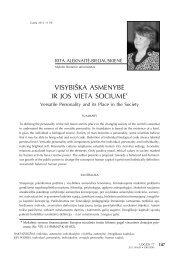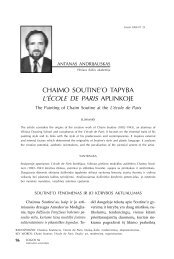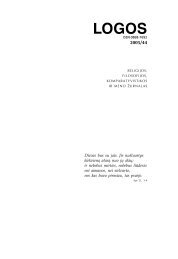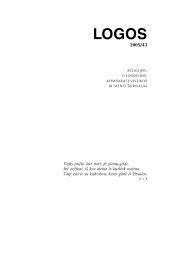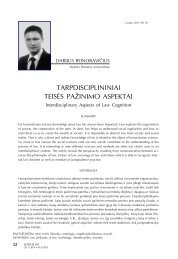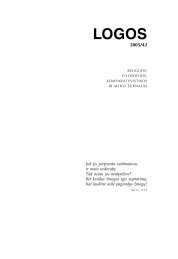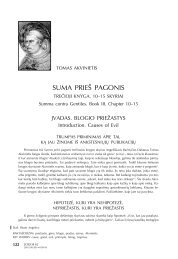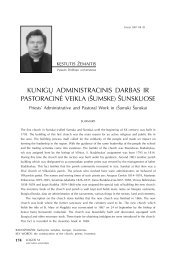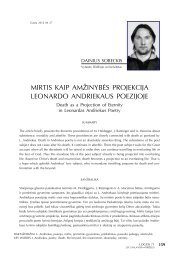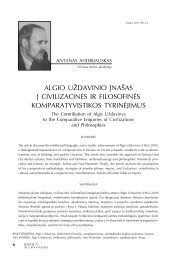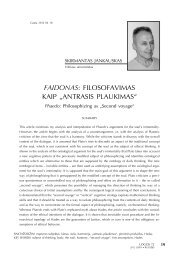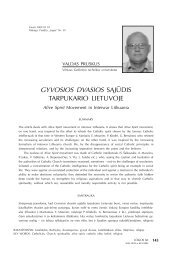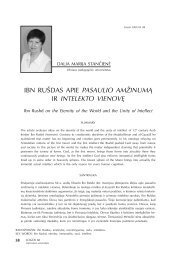Argi papirusas gali augti ten, kur nėra pelkių? Argi nendrės ... - Logos
Argi papirusas gali augti ten, kur nėra pelkių? Argi nendrės ... - Logos
Argi papirusas gali augti ten, kur nėra pelkių? Argi nendrės ... - Logos
You also want an ePaper? Increase the reach of your titles
YUMPU automatically turns print PDFs into web optimized ePapers that Google loves.
LEONARDA JEKENTAITË<br />
VATIKANO DOKUMENTAI<br />
DEMONIÐKOJO ESTETIZMO PAVIDALAI<br />
ÐIUOLAIKINËJE LIETUVOS KULTÛROJE<br />
The Main Features of Demonic Aestheticism in Lithuanian Culture<br />
SUMMARY<br />
One of the most significant trends in postmodern Lithuanian art (the painter Ð. Sauka, the writers S.<br />
Parulskis, S. Geda, A. Andriuðkevièius, G. Radvilavièiûtë, G. Beresnevièius, the theatre director O. Korðunovas)<br />
can be characterised using Kierkegaardian terminology as demonic aestheticism. The essence<br />
of this phenomenon are: narcissism, exis<strong>ten</strong>tial irony and „debauched“ self-will, always challenging and<br />
destroying all limits and taboos. The origin of their always extremely strong expression is their selfsacrificing<br />
devotion to their Art as to the only God and the same playful indifference to the discrepancies<br />
between fiction and reality, daydreams and nightmares. Their art is perfect professionally and full<br />
of deeply authentic suffering. The themes of angels, sin, crime and efforts to understand their attitude<br />
to God are always painful, cynical, and related to eroticism, perversion and death. The force of the<br />
expression arises from mental experiments in destruction and self-destruction which are signs of a longing<br />
for the traumatically lost sense of the certainty of reality and positive faith in God.<br />
SÖRENO KIERKEGAARD’O ÁÞVALGØ AKTUALUMAS<br />
Straipsnio pavadinime panaudotas<br />
terminas demoniðkasis estetizmas – ypatingas<br />
egzis<strong>ten</strong>cinis þmogaus santykis su<br />
pasauliu ir postûmis meninei kûrybai –<br />
yra itin nuodugniai aptartas Söreno<br />
Kierkegaard’o (1813–1855) filosofijoje.<br />
Vilniaus universitetas<br />
Gauta 2003-06-27<br />
Tai, kad 2003 m. geguþës 5 d. sukako<br />
190 metø nuo áþymiojo danø filosofo gimimo<br />
dienos, yra gera proga pagerbti ðá<br />
màstytojà ir, naudojantis jo áþvalgomis,<br />
panagrinëti kai <strong>kur</strong>iuos bûdingiausius<br />
ðiø dienø Lietuvos kultûros reiðkinius.<br />
RAKTAÞODÞIAI. Demonizmas, estetizmas, egzis<strong>ten</strong>cija, ironija, iðtvirkusi valia, savidestrukcija.<br />
KEY WORDS. Demonism, aestheticism, exis<strong>ten</strong>ce, irony, depraved will, self-destruction.<br />
LOGOS 34<br />
2003 LIEPA • RUGSËJIS<br />
165



